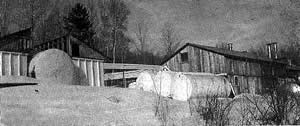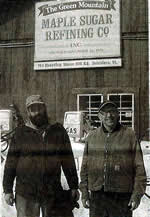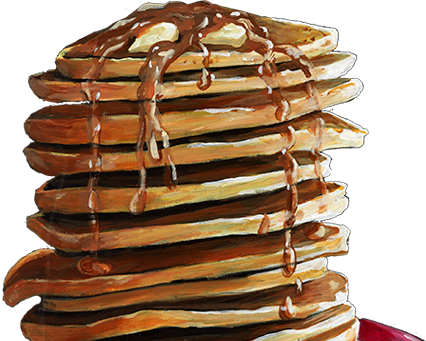News and Citizen Volume 122, No25 No5532, March 24, 2005
by Alicia Morissette March 18, 19 and 20 were the days in which people could tour sugarhouses across Vermont and see what sort of sugary goodies can be made from sap. Some sugarhouses were only open on Saturday and Sunday, and some were not open at all.
March 18, 19 and 20 were the days in which people could tour sugarhouses across Vermont and see what sort of sugary goodies can be made from sap. Some sugarhouses were only open on Saturday and Sunday, and some were not open at all.
The Green Mountain Maple Sugar Refining Co., Inc. (GMMSR) was not open to the public, but is a large operation. GMMSR is at the top of Boarding House Hill Road in Belvidere, and is owned by Joe Russo, who has a unique way of sugaring and is concerned with conserving Vermont’s natural resources.
After founding GMMSR on November 12, 1991, Russo has been creating new equipment that has helped sugarmakers and the environment. His newest invention, the Russo Economizer, was tried for the first time on Monday, March 21, and will “decrease the time and energy used in maple syrup production,” said Russo. He also added that his invention will be patented soon.
Russo’s method of turning sap into sugar requires a lot of steps, a lot of time, a unique technique and some help. Russo lives in the sugarhouse during the sugaring season, and is helped by two people, who are there full-time and year-round. Randy Dezotelle is the manager and Michael Lemire is the assistant manager.
During the season, Dezotelle and Lemire are responsible for tapping thousands of trees. This year, they have tapped 47,000 trees, and each year they increase their number by 10,000. According to Dezotelle, they have between three and 12 people helping them on snowshoes, but the number of employees vary, because Russo, Dezotelle and Lemire “can’t figure on help showing.”
The trees are drilled with battery powered drills instead of gas drills and are tapped with a 5/16 inch spout instead of a 7/16 inch spout, which is “better for tree health,” said Dezotelle. Plastic lines are then run from the spouts. The sap is then pumped from the lines by ten 10-horsepower pumps, which “create a vacuum,” explained Russo. The sap is drawn into seven three-inch lines, delivered to a sap releaser which pumps the sap out of the vacuum into tanks that can collectively hold 80,000 gallons of sap. Just on Sunday, March 20, the tanks had collected 30,000 gallons of sap.
The sap is then pumped from the lines by ten 10-horsepower pumps, which “create a vacuum,” explained Russo. The sap is drawn into seven three-inch lines, delivered to a sap releaser which pumps the sap out of the vacuum into tanks that can collectively hold 80,000 gallons of sap. Just on Sunday, March 20, the tanks had collected 30,000 gallons of sap.
Then much of the sap’s water is removed via reverse osmosis and this “permeate” is brought to the boiling pan, the place where Russo’s unique technique of boiling takes place.
A 250 horsepower high pressure steam boiler is used to evaporate the rest of the water from the permeate. The steam travels through stainless steel pipes which end up in the boiling pan. This method, said Russo, “never burns the pan.”
The final product is released from the draw-off center, which actually calculates when the maple syrup is done. Two valves open, and the syrup is let out. According to Russo, GMMSR can potentially make six 50 gallon drums of syrup per hour, but they usually produce three 50 gallon drums.
To ensure the highest quality product, Russo keeps everything the sap touches clean and all of the inside equipment the sap comes in contact with is stainless steel.
All of GMMSR’s power is provided by a 300 horsepower electrical generator, and Russo uses a wood boiler to heat the building and the hot water. The water and heat are crucial, partly because Russo lives in a back room in the sugarhouse during the sugaring season!
GMMSR’s entire building and sugaring set-up was designed by Russo, who has a food engineering degree from Delaware Valley College in Doylestown, PA. Between his degree and his knowledge of sugaring, Russo has the ability to create new equipment to better the sugaring process.
When Russo is not inventing new things and sugaring between the months of February and April, he is a hotel manager for an ocean liner and lives in Australia. It’s a very different from sugaring; Russo said,”I go from a tuxedo to Carhartt’s.”
Rick Marsh has a different lifestyle from Russo, but he and his wife, Diane, love maple sugaring, too. Rick is a fifth generation sugarmaker, who is continuing the tradition his family has been following for 95 years.
Located on Route 15 in Jeffersonville, the Vermont Maple Outlet has been in business for 16 years. The normal business hours are 9:00 a.m. until 5:00 p.m., but on March 19 and 20 the Marshs held special activities between 10:00 a.m. and 4:00 p.m.
According to Diane, she and Rick were open to show visitors the boiling process, give wagon rides into their trees behind the store, showed educational videos about the progressive history of boiling. Of course, maple cotton candy, sugar on snow, maple creemees and maple cream doughnuts were for sale.
Rick said, “this is the first year the sap’s going to flow” during open house, and his prediction was accurate. Last year, the Marshs saw approximately 1,200 people, according to Rick. This year, there were more people “due to the weather,” according to Diane.
The official Vermont Maple Open House weekend was started four years ago by the Vermont Sugarmakers Association, of which Rick is the vice president. He explained that in order to be part of the list in a Ski & Maple Map, sugarmakers pay a fee which depends on several factors.
The size of the producer, the business status of the producer and the number of taps the producer has, among other factors, determines the fee. Rick said he pays $50, but he operates both a retail and wholesale business and has a lot of taps.
The Vermont Maple Outlet promotes a “maple theme,” which coincides with the Marshs’ “support of Vermont companies” and products, said Rick.
To Rick, maple sugaring is a time-honored tradition, but he has incorporated scientific innovations, such as reverse osmosis. Reverse osmosis “cuts boiling time down drastically,” Rick commented. Modern has met tradition.



